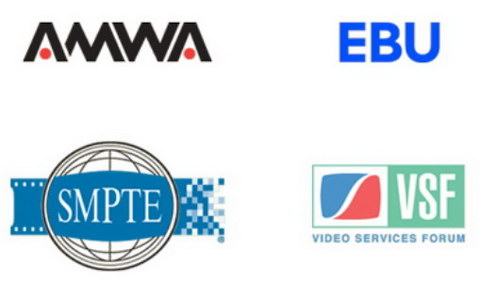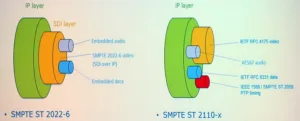On October 15th, The New York chapter of SMPTE hosted Matthew Goldman who gave a talk titled, in part, “Broadcast Migration to IP [Internet Protocol]” Goldman is the current President of SMPTE and his day job is SVP Technology at MediaKind, which was formerly Ericsson Media Solutions.
Matthew Goldman receiving a plaque for his SMPTE-NY talk from the talk’s organizer, Mike Strein, Director, Engineering and Technology, ABC-TV/ABC News. (Credit: M. Brennesholtz)
Goldman emphasized that “Video over IP” would be an inadequate title because broadcast content contains more than video. It also includes audio and ancillary data such as subtitles and metadata. These different types of data all must reach their destination still synchronized with each other. This synchronization is done by using the IEEE Precision Time Protocol, originally developed to ensure financial transactions such as high-speed trading were time-stamped correctly.
SMPTE 2022-6 compared to 2110-X. Note that content traveling over IP in the 2022-6 standard travels together within a SDI wrapper. For 2110-X, there is no wrapper and the multiple streams are synchronized with the IEEE PTP. (Credit: Matthew Goldman)
In the previous SMPTE standard for broadcast media over IP, known as SMPTE ST2022-6 “Transport of High Bit Rate Media Signals over IP”, these three types of data were combined with the same protocols used in SDI connections. Goldman said that ST2022-6 could be thought of as SDI over IP. This approach had the advantage of being familiar to everyone in the broadcast engineering space. It has the disadvantage, however, of limiting the flexibility inherent in IP. Typically ST 2022-6 would be used as a part of an SDI-based facility, where a new connection via IP would run in parallel with many existing connections via SDI cabling. This standard has not been made obsolete by ST 2110 and will remain in force.
 (Credit: Matthew Goldman)
(Credit: Matthew Goldman)
The new standard, ST 2110, “Professional Media Over Managed IP Networks,” is actually a suite of standards, as shown in the image. There are two key phrases in the title of this group of standards. First, “Professional Media” means this standard is for use by content creators, broadcasters, etc. It is not intended for applications such as moving professional AV content from the server to the displays (HDbaseT) or for streaming to the public. Second is “Managed IP Networks.” This standard is for real-time distribution of content over internal IP networks of post-production houses, broadcasters, etc and is not intended for use over the public Internet. This standard is for real-time transfer of the content and is not for off-line transfer of files from one server to another.
The key standards in ST 2110-X have all been approved by SMPTE. The standard includes timing with PTP (2110-10), uncompressed video (2110-20), ancillary data (2110-40), delivery (2110-21) and audio (2110-30 for PCM; 2110-31 for AES3). Note that the compressed video standard (2110-22) is not yet approved but compressed video is not a major issue with the content creators, post-production houses and broadcasters that are the targets of the standard. RP (Recommended Practice) 2110-23 is also not yet approved. This deals with using multiple ST 2110 streams in parallel to increase data rates. For ordinary 4K video, this shouldn’t be an issue because IP streams can have very high data rates. Perhaps for someone considering 8K HFR content, this may become a problem in the future although IP data rates are increasing as fast as or faster than the demands of media.
 JT-NM Admin Group members.
JT-NM Admin Group members.
The SMPTE is not working alone on ST2110-X standards, it is working within the Joint Task Force on Networked Media, JT-NM. The JT-NM is a partnership of the AMWA (Advanced Media Workflow Association), EBU (European Broadcast Union), VSF (Video Services Forum) and SMPTE. When I asked Goldman if there were competing standards for the ST 2110-X suite, perhaps in China, his short answer was “No.” He said that China has been very supportive of SMPTE and the JT-NM and he expects the ST 2110 standards to be global standards.
I spent a day at NAB New York this week, an event that also caters to the same content creator, post-production and broadcaster crowd. Virtually every equipment, software or service provider was discussing broadcast quality media over IP. Most of the “new” equipment at the event had previously been introduced at NAB 2018 or IBC 2018 and covered in Meko’s special reports for these events. There were some things there that are either new since IBC or were missed so I will be writing a short report on NAB New York for next week’s newsletter.
In his role as President of SMPTE, Goldman also gave a short plug for the upcoming SMPTE annual conference in Los Angeles next week, running from October 22 through 25. He discussed keynote speakers, the technical conference and the exhibition. He also discussed the special events at the SMPTE conference. My favorite was the Charity Fun Run. SMPTE doesn’t do 5K or 10K runs – this is to be a 4K run. –Matthew Brennesholtz

